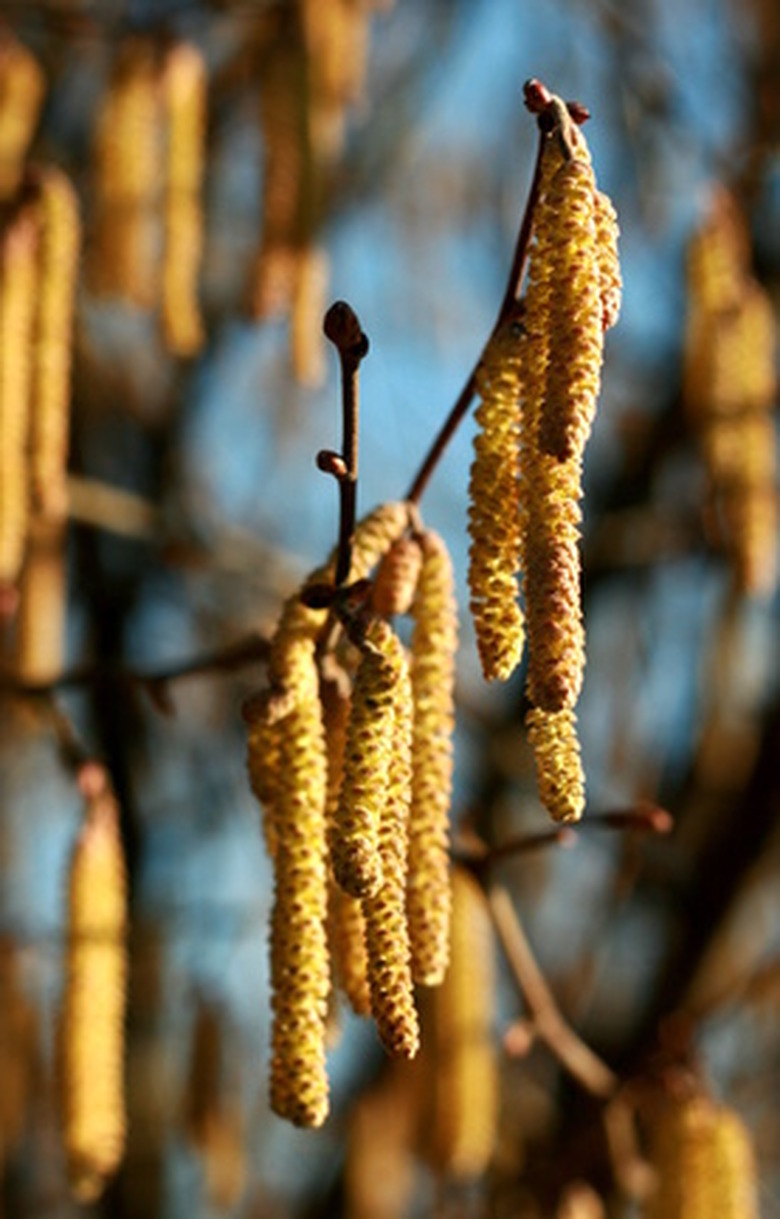The Pollination Of Hazelnut Trees
The hazelnut tree (Corylus avellana) is also known as the European filbert or cobnut. It is a member of the birch or Betulaceae family, related to walnuts, alders and birches. Native to Europe, it can grow up to 25 feet in height and has a shrubby, multistemmed growth habit. Corylus avellana is distinguished by its broad, alternate, toothed leaves and somewhat bristly twigs. The edible nuts have hard shells. Pollination of Corylus avellana is by wind.
Flowers and Pollination
Members of the Corylus genus, including hazelnut trees, are monoecious, with flowers of both sexes on a single plant. The male flowers form the characteristic fuzzy-looking spring catkins that can be up to 3 inches long. The female flowers are insignificant, with the sexual parts, stigma and style barely protruding from the flower bud. This flower configuration, according to botanist Martyn Rix, is an adaptation that facilitates wind pollination. One factor that sometimes hinders pollination is temperature, as flowers can be damaged if temperatures dip below 15 degrees Fahrenheit.
- The hazelnut tree (Corylus avellana) is also known as the European filbert or cobnut.
- This flower configuration, according to botanist Martyn Rix, is an adaptation that facilitates wind pollination.
Producers or Pollinators
Because the trees are monoecious, any hazelnut tree can produce nuts. In commercial production, however, growers generally plant two different varieties within 50 or 60 feet of each other to facilitate cross pollination via wind. Growers choose one variety that is a good pollinator and a second that is a good nut producer. The pollinator will produce its own crop of nuts, but the crop will not be as heavy or of the same quality as the producer's nuts.
Hazelnuts
Hazelnut or filbert trees produce nuts after about four years, but do not reach maximum production until they are at least 7 years old. The nuts ripen in October in the American Pacific northwest and fall from the trees as soon as they are ripe. Hazelnuts are enclosed in a protective husk, which is generally easy to remove from the ripe nut.
- Because the trees are monoecious, any hazelnut tree can produce nuts.
- Hazelnuts are enclosed in a protective husk, which is generally easy to remove from the ripe nut.
Hazelnut Uses
Hazelnuts have long been appreciated in Europe for their flavor. They are grown commercially in northern Turkey, near the Black Sea, and in Kent, England. In the United States, Oregon, where the trees were probably introduced by early French settlers, is a center of commercial production. The nuts are high in beneficial mono-unsaturated fats. They are eaten by themselves or used in baked goods and candies. The oil is also sometimes extracted and used for culinary or cosmetic purposes. Historically, mashed or ground filberts combined with other ingredients were used to treat coughs and colds.
- Hazelnuts have long been appreciated in Europe for their flavor.
- Historically, mashed or ground filberts combined with other ingredients were used to treat coughs and colds.
Broadening Hazelnut Culture
Because pollination cannot take place if flowers are damaged by cold temperatures, hazelnut culture in the United States has been limited geographically to the Pacific Northwest. Over the past several decades scientists in several U.S. locations have worked to develop more cold-tolerant varieties that are also resistant to the Eastern Filbert Blight. Scientists at Rutgers University in New Jersey are working with recently bred, improved hazelnut varieties to create even better varieties that can be grown for both commercial and ornamental use in the eastern United States and other similar climate zones.
References
- "The Botanical Garden"; Roger Phillips and Martyn Rix; 2002.
- Washington State University: Spokane Extension: Filbert Culture
- Oregon Hazelnut Marketing Board: Oregon Hazelnuts
- Arbor Day Foundation: Developing Hazelnuts for the Eastern United States
